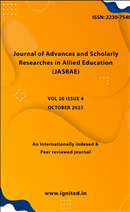Comparative Analysis of Clustering Algorithms for Large-Scale Data sets using Self-Organizing Maps
Keywords:
comparative analysis, clustering algorithms, large-scale data sets, self-organizing maps, dimensionality reduction, input data, lower dimensions, clusters, new enrolled students, academic grades, SOM learning algorithm, cluster analysis, distinct groupings, comparable, dissimilar, prototypes, quantify differences, Euclidean distanceAbstract
However, SOM is also known as one of clustering techniques, since dimensionality reductionmay also be seen as reducing (or clustering) input data to lower dimensions (or clusters). This researchaims to group new enrolled students to a high school based on their academic grades using a SOMlearning algorithm. The goal of cluster analysis is to identify distinct groupings within the data. Theobjects that belong to the same group ought to be comparable to one another, while those belonging todifferent groups ought to be as dissimilar to one another as is practicable. When dealing with clusteringdifficulties, one is particularly interested in the characterization of the clusters through the use ofprototypes, which can be objects that are typical, representational, or representative in nature. There area variety of ways to quantify differences between things. In this particular piece of research, theEuclidean distance was utilized as the comparative tool.References
A. Imron, "Management of School-based Students" (Manajemen Peserta Didik Berbasis Sekolah), Malang: Universitas Negeri Malang, 2012.
T. Kohonen, "Self-organized formation of topologically correct feature maps," Biological Cybernetics, vol. 43, no. 1, pp. 59--69, 1982.
I. Y. Purbasari, F. T. Anggraeny and N. Harianto, "Classification of broiler chicken eggs using support vector machine (svm) and feature selection algorithm," in International Joint Conference on Science and Technology, Nusa Dua, 2018.
M. Maimunah and T. Rokhman, "Classification of Declining Quality of Chicken Eggs Based on the Color of Shells Using Support Vector Machine "(Klasifikasi Penurunan Kualitas Telur Ayam Ras Berdasarkan Warna Kerabang Menggunakan Support Vector Machine)," Informatics for Educators and Professionals, vol. 3, no. 1, pp. 43-52, 2018.
D. Nurdiyah and I. A. Muwakhid, "Comparison of Support Vector Machine and K-Nearest Neighbor for Fertile and Infertile Egg Classification Based on Glcm Texture Analysis " (Perbandingan Support Vector Machine dan K-Nearest Neighbor Untuk Klasifikasi Telur Fertil Dan Infertil Berdasarkan Analisis Texture GLCM), Jurnal Transformatika, vol. 13, no. 2, pp. 29-34, 2016.
S. Lakho, A. H. Jalbani, M. S. Vighio, I. A. Memon, S. S. Soomro and S. Q. N, "Decision Support System for Hepatitis Disease Diagnosis using Bayesian Network," Journal of Computing and Mathematical Sciences, vol. 1, no. 2, pp. 11-19, 2017.
F. Anggraeny, I. Purbasari and E. Suryaningsih, "ReliefF Feature Selection and Bayesian Network Model for Hepatitis Diagnosis," in International Conferences on Information Technology and Business (ICITB), Bandar Lampung, 2017.
F. T. Anggraeny, "Prediction of Student's Academic Achievement using Artificial Neural Network (Prediksi Prestasi Akademik Mahasiswa dengan Metode Jaringan Syaraf Tiruan)," in National Seminar of Information Technology Roles in Food, Chemical, and Manufacturing Industries to Support Development (Seminar Nasional Peran Teknologi Informasi di Bidang Industri Pangan, Kimia, dan Manufaktur dalam Menunjang Pembangunan), Universitas Pembangunan Nasional "Veteran" Jawa Timur, Surabaya, 2009.
S. Isljamovic and M. Suknovic, "Predicting Students' Academic Performance using Artificial Neural Network: A Case Study from Faculty of Organizational Sciences," in The Eurasia Proceedings of Educational & Social Sciences (EPESS), Konya, Turkey, 2014.
O. L. Usman and A. O. Adenubi, "Artificial Neural Network (ANN) Model for Predicting Students' Academic Performance," Journal of Science and Information Technology, vol. 1, no. 2, pp. 23-37, 2013.
E. Y. Obsie and S. A. Adem, "Prediction of Student Academic Performance using Neural Network, Linear Regression and Support Vector Regression: A Case Study," International Journal of Computer Applications, vol. 180, no. 40, pp. 39-47, 2018.
L. Rahmawati, A. D. Cahyani and S. S. Putro, "Utilization of SOM-IDB cluster method as an Analysis of Scholarship Acceptance Analysis (Pemanfaatan metode cluster SOM – IDB sebagai Analisa Pengelompokan Penerimaan Beasiswa)," University of Trunojoyo Madura, Bangkalan, 2013.
N. Hendayanti, G. Putri and M. Nurhidayati, " Accuracy of Classification of STMIK STIKOM Bali Scholarship Recipients with Hybrid Self Organizing Maps and K-Mean Algorithms (Ketepatan Klasifikasi Penerima Beasiswa STMIK STIKOM Bali dengan Hybrid Self Organizing Maps dan Algoritma K-Mean)," VARIAN Journal, vol. 2, no. 1, pp. 1-7, 2018.
M. Bara, N. Ahmad, M. Modu and H. Ali, "Self-organizing map clustering method for the analysis of elearning activities," in Majan International Conference (MIC), Muscat, Oman, 2018.
Y. Lee, "Using Self-Organizing Map and Clustering to Investigate Problem-Solving Patterns in the Massive Open Online Course: An Exploratory Study," Journal of Educational Computing Research, vol. 57, no. 2, pp. 471-490, 2019.








